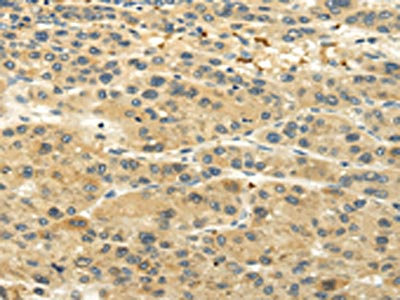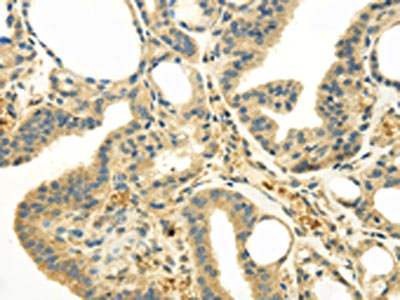
The image on the left is immunohistochemistry of paraffin-embedded Human liver cancer tissue using CSB-PA230502(UGT1A6 Antibody) at dilution 1/20, on the right is treated with synthetic peptide. (Original magnification: x200)
UGT1A6 Antibody
CSB-PA230502
ApplicationsELISA, ImmunoHistoChemistry
Product group Antibodies
ReactivityHuman
TargetUGT1A6
Overview
- SupplierCusabio
- Product NameUGT1A6 Antibody
- Delivery Days Customer20
- ApplicationsELISA, ImmunoHistoChemistry
- CertificationResearch Use Only
- ClonalityPolyclonal
- ConjugateUnconjugated
- Gene ID54578
- Target nameUGT1A6
- Target descriptionUDP glucuronosyltransferase family 1 member A6
- Target synonymsBilirubin-specific UDPGT isozyme 1; GNT1; HLUGP; HLUGP1; hUG-BR1; phenol-metabolizing UDP-glucuronosyltransferase; UDP glucuronosyltransferase 1 family, polypeptide A6; UDP glycosyltransferase 1 family, polypeptide A6; UDP-glucuronosyltransferase 1 family polypeptide A6s; UDP-glucuronosyltransferase 1-1; UDP-glucuronosyltransferase 1-3; UDP-glucuronosyltransferase 1-5; UDP-glucuronosyltransferase 1-6; UDP-glucuronosyltransferase 1-A; UDP-glucuronosyltransferase 1A1; UDP-glucuronosyltransferase 1A3; UDP-glucuronosyltransferase 1A5; UDP-glucuronosyltransferase 1A6; UDP-glucuronosyltransferase 1-C; UDP-glucuronosyltransferase 1-E; UDP-glucuronosyltransferase 1-F; UDPGT; UDPGT 1-6; UGT1; UGT1.1; UGT1.3; UGT1.5; UGT1.6; UGT1-01; UGT1-03; UGT1-05; UGT1-06; UGT1A; UGT-1A; UGT1A1; UGT1A3; UGT1A5; UGT1A6S; UGT1C; UGT-1C; UGT1E; UGT-1E; UGT1F; UGT-1F
- HostRabbit
- IsotypeIgG
- Protein IDP19224
- Protein NameUDP-glucuronosyltransferase 1-6
- Scientific DescriptionThis gene encodes a UDP-glucuronosyltransferase, an enzyme of the glucuronidation pathway that transforms small lipophilic molecules, such as steroids, bilirubin, hormones, and drugs, into water-soluble, excretable metabolites. This gene is part of a complex locus that encodes several UDP-glucuronosyltransferases. The locus includes thirteen unique alternate first exons followed by four common exons. Four of the alternate first exons are considered pseudogenes. Each of the remaining nine 5 exons may be spliced to the four common exons, resulting in nine proteins with different N-termini and identical C-termini. Each first exon encodes the substrate binding site, and is regulated by its own promoter. The enzyme encoded by this gene is active on phenolic and planar compounds. Alternative splicing in the unique 5 end of this gene results in two transcript variants.
- ReactivityHuman
- Storage Instruction-20°C or -80°C
- UNSPSC12352203

